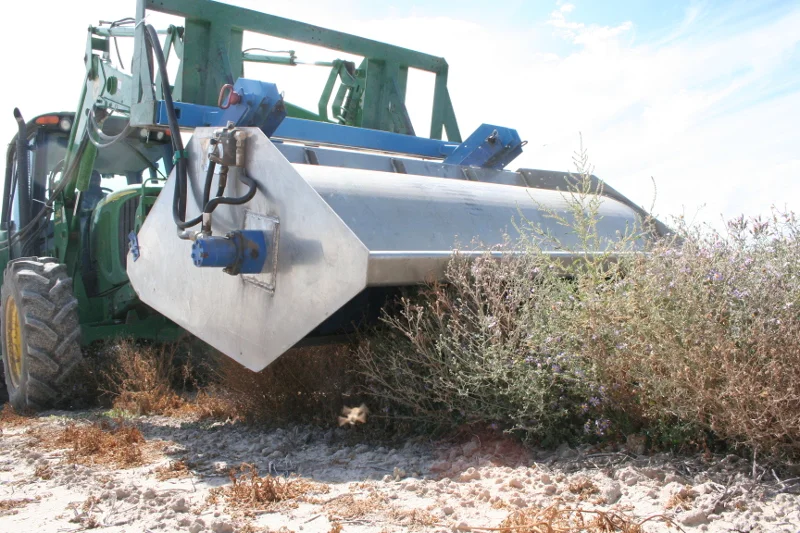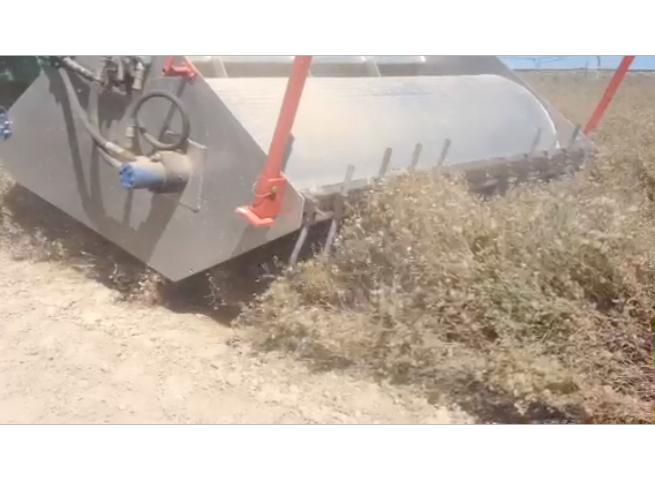Derek Tilley, Manager, USDA-NRCS Aberdeen Plant Materials Center
Derek.tilley@id.usda.gov
Indeterminately maturing, wind-dispersed wildflower seeds can be difficult to effectively harvest to maximum yields using traditional equipment. We modified a Flail-Vac Seed Stripper by mounting heavy loops of chain to the front to provide agitation of the floral canopy to disarticulate mature seed from the flowers of hoary aster (Machaeranthera canescens). This allowed for multiple, non-damaging harvests that collected primarily ripe seed that was ready to shatter. We saw a 5-fold increase in seed yields compared to yields obtained with a standard Flail-Vac and a significant reduction in seed processing time compared to our previous harvest experience.
Two obstacles to native forb seed production and harvest are indeterminate ripening and light pappus-bearing seed evolved for wind dispersal. For optimum yields, indeterminately ripening species require multiple harvests to capture seed as it ripens and before it disarticulates and falls to the ground. Seed of wind-dispersed species such as those in the Asteraceae are particularly difficult to harvest without losing significant amounts of seed. Currently available means of mechanical harvesting that allow for multiple harvests are limited. Hand or vacuum-assisted harvesting is often used, but can be labor intensive and increase costs.
Over the last few years we have examined several techniques for harvesting light airborne seed with varying levels of success. Direct combining takes relatively little time in the field, but this method yields correspondingly less seed due to the limitation of obtaining only a single harvest. Additionally it requires significantly more time to clean the seed compared to other methods because of the large amounts of inert matter collected. Leaf vacuums and jet harvesters developed for harvesting forb seed work well, but creating even distribution of the suction has been problematic.
The use of a Flail-Vac harvester (Woodward Flail-Vac Seed Stripper, Ag-Renewal Inc., Weatherford, Oklahoma), can be a viable alternative in some cases, but this harvester can be highly destructive, and it limits the number of times one can go through the field. The nylon brushes are set down into the plants and must whip at high speeds to remove the seed from the plants and create the suction required to pull the seed into the hopper in the rear (Fig. 1). This process unfortunately causes significant damage to mature and immature flowers and allows for about two harvests before the canopy is effectively destroyed. Flail-Vac harvesting also adds more inert matter that must be cleaned out during later processing.
Hoary tansyaster exemplifies the problems associated with harvesting fluffy seed that ripens over a long maturation window. Hoary tansyaster has a small seed (achene) with a pappus of capillary bristles that facilitates airborne dispersal. The seed is very light with approximately 1.3 million seeds/lb (2.9 million seeds/kg). The plants produce numerous indeterminately ripening flowers that are scattered throughout the plant (not just on the periphery of the canopy).
In 2012 we direct combined a hoary tansyaster field using a research plot combine. From a 0.6 acre (0.2 ha) field we harvested 55 lb (25 kg) of material which cleaned to only 0.75 lb (0.34 kg) of pure seed, equivalent to 1.3 lb/ac (1.5 kg/ha). In 2013 we harvested hoary tansyaster using a Flail-Vac seed stripper set to harvest approximately the top 8 to12 inches (20 to 30 cm) of the plants (Figure 1). We completed two harvests using the Flail-Vac for a combined total of 7.3 lb (3.3 kg) of pure seed, equivalent to 12.2 lb/acre (13.7 kg/ha). Only two harvests were possible because of the destructive action of the Flail-Vac brush on the plants (Fig. 2).
Figure 1. A standard Flail-Vac is set deep into the plant canopy of hoary tansyaster enabling the nylon brush to strip seed off of the plant. This technique both damages the plant, limiting the number of harvest, and accumulates significant amounts of vegetative material with the harvested seed. Photo by Derek Tilley.
Figure 2. Harvested material from a standard Flail-Vac contains significant amounts of vegetative material. Green leaves, stems and actively blossoming flowers attest to the damage done and potential seed lost. Photo by Derek Tilley.
In 2015 we experimented with two modifications to the standard Flail-Vac harvester in an attempt to increase yields of pappus-bearing seed. In the first iteration we created a rigid pipe rake by mounting thirteen 24-inch (61 cm) lengths of 0.75 inch (1.9 cm) galvanized tubing to the front of the Flail-Vac hood. We configured each section of pipe to run a short length (6-12 inches [15-30 cm]) into the plant canopy. The Flail-Vac head itself was elevated just above the plants so that the brushes had minimal contact with the flowers (Fig. 3).
Figure 3. A rigid pipe rake installed on the hood of the Flail-Vac effectively agitated the floral heads knocking seeds loose and allowing them to be sucked in by the suction created from the rotating brushes. Plants tended however to hang up on the rigid pipes and break or uproot. Photo by Derek Tilley.
Seed yields were promising. Unfortunately, we found this technique to be more damaging to the plants than we wanted. The tubes were very effective at agitating the plant canopy and shaking the ripe seed from the flowers. They also left non-ripe flowers and vegetation intact. However plants were frequently hung up on the pipes and dragged until they were broken or uprooted. We had to stop the tractor regularly to lift the arms and remove broken stems and plants from the front of the Flail-Vac.
In the second iteration we removed the lengths of pipe and replaced them with loops of heavy chain (Fig. 4). Six chains were hung from the mounting points created in the initial modification using zip ties. Chains hung approximately 26 inches (66 cm) from the mounting points, which placed a significant portion of their length within the plant canopy. We used 0.5 inch (1.3 cm) log chain which weighs approximately 2 lb/ft (3 kg/m). The chain had enough weight to extend into the canopy and apply pressure to the plants, but was it was less rigid than the solid rake. As the chains dragged through the plants, the outer chain loops pushed the outer portion of the plants to the center of the rows away from the tires and into the path of the Flail-Vac. Ripe seed was knocked off of the flowers and the loose seed was caught by the air current created by the rotating brush. This method caused very little, if any, damage. We experienced no broken large stems or uprooted plants using the chain method.
Figure 4. Loops of heavy log chain replaced the rigid pipe rake allowing for multiple, non-destructive harvests. Photo by Derek Tilley.
We went through a 1.0 acre (0.4 ha) field a total of 8 times over a period of 21 days with the modified Flail-Vac. Each harvest was run in the opposite direction of the previous run. Immediately after harvests the plants were often leaning over from the weight of the heavy chain, but after a day or two they had regained their upright habit. Total weight of uncleaned seed was 422 lb (192 kg), and the final yield of clean seed was 64.8 lb (29.4 kg).
The harvested materials consisted primarily of seed, pappus fluff and involucral bracts. There was a negligible amount of stem material that could easily be separated with a hay fork as the seed dried prior to initial bagging (Fig. 5). The time required to dry harvested material, which can be an issue, was greatly reduced because we harvested only ripe seed and no green vegetative matter. Cleaning time and labor were significantly reduced, due to the smaller amounts of rigid stem material that often clogs and bridges in processing equipment.
Figure 5. Hoary tansyaster seed harvested with a chain-modified Flail-Vac contains very little vegetative matter making it easier to dry and clean. Photo by Derek Tilley.
Though precise comparisons can’t be made because we harvested in subsequent years under different conditions, we observed a clear improvement in hoary tansyaster seed yields due to the increased number of harvests performed. The chain-modified Flail-Vac yielded 5.4 times the amount of seed per acre compared to the standard Flail-Vac, and 50 times more than a single harvest using a combine. Several species are known to possess seed characteristics similar to hoary tansyaster, namely indeterminate ripening and light airborne dispersal, and may be effectively harvested with a chain-modified Flail-Vac. These species belong primarily to the Asteraceae and include species of Symphiotrichum, Crepis, Solidago, Packera, and Agoseris. Additional species that may be harvested by this method are found in other families such as Onagraceae and Asclepiadaceae.t conditions, we observed a clear improvement in hoary tansyaster seed yields due to the increased number of harvests performed.





